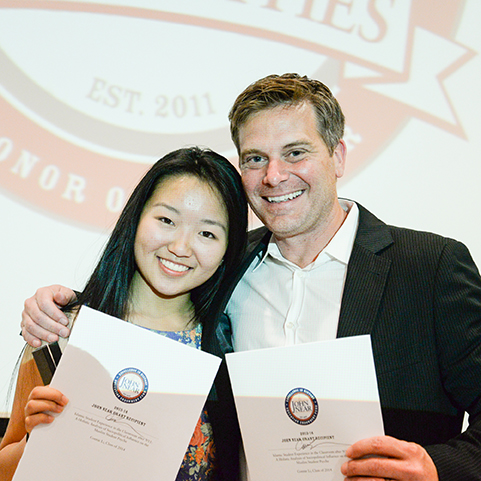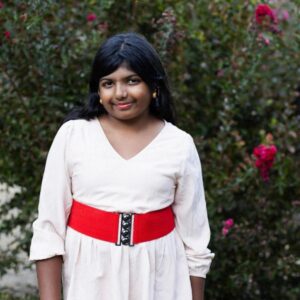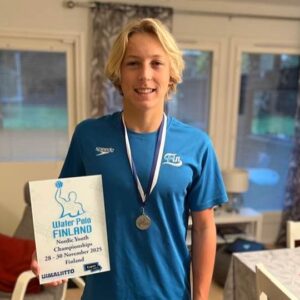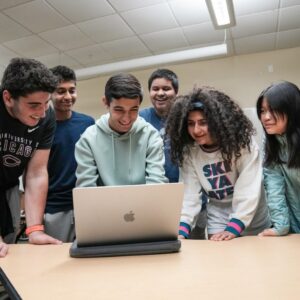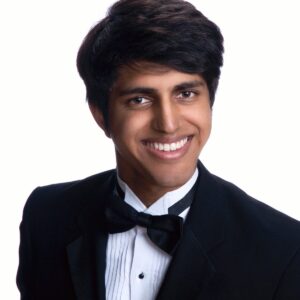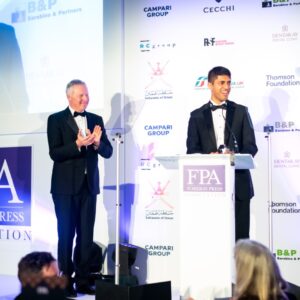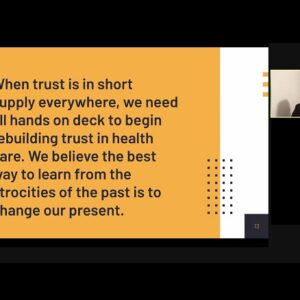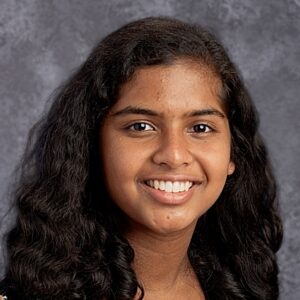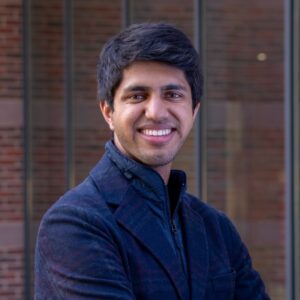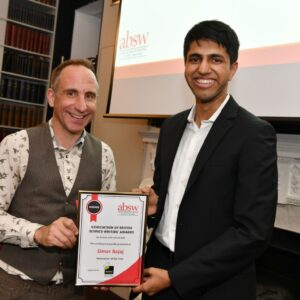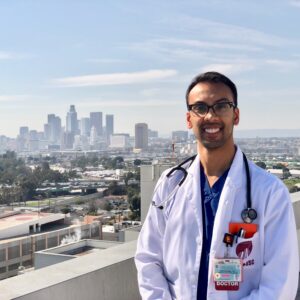This story originally appeared in the spring/summer 2020 issue of Harker Magazine.
By Marla Holt
Simar Bajaj, a Harker senior with dual interests in history and medicine, spent a large part of his senior year researching and writing about the complex impacts of the “The Flexner Report” of 1910, a landmark paper that established high standards for today’s four-year medical school system while also nearly eliminating the path to medicine for women, African Americans and the working class.
“The report’s most harmful effect was to make the medical profession the domain of white middle- and upper-class men,” said Bajaj, who conducted much of his research at Stanford University’s Lane Medical Library, pouring over countless journal articles and books related to the history of medicine.
Seniors Kathy Fang and Ellen Guo also were hard at work conducting independent research on topics about which they are passionate.
The three students and five of their classmates were this year’s participants in Harker’s Near/Mitra scholars program, which is celebrating its 10th year. The program supports eight to 10 seniors in pursuing academically rigorous, independent research on a topic of their choice in U.S. history, literature, art, music and the social sciences. The student scholars are selected in the spring of their junior year, after which they work with one or two faculty mentors and a librarian to refine their research topics. The majority of their research is conducted over the summer, with additional research and writing continuing through the fall and winter. Their lengthy papers, similar to a college thesis, are published by Harker and presented at a reception in April.
Fang spent last summer at the University of Cambridge, the National Archives in London’s Kew Gardens and the Folger Institute in Washington, D.C., examining the portrayal of women and gender roles in Restoration adaptations of Shakespeare in light of the advent of actresses in public theaters. Her research led her to conclude that “women’s status in the public sphere was degraded by playwrights who created oversexualized female characters,” she said.
Meanwhile, Guo focused on examining bisexuality in the queer theory canon. She conducted a close read of Eve Sedgwick’s “Epistemology of the Closet” and then applied modern theorizing about bisexual identity and experience to the author’s theses. “This project has expanded my thinking beyond binary-isms and the limits of naturalized, Western thought,” she said.
The skills and lessons Near/Mitra scholars learn are varied, said library director Lauri Vaughan, who co-directs the program with history teacher Donna Gilbert. Overall, students strengthen their critical thinking, writing and reading comprehension skills through high-level interdisciplinary research. They also become more tenacious and resilient.
“We don’t give the Near/Mitra scholars a roadmap, so they undertake a big, messy process of truly organic research,” Vaughan said. “It becomes a personal journey of exploration.”
High-Level Research Support
Launched in 2009, the Near/Mitra scholars program is managed by the history department with support from the library. The John Near Excellence in History Endowment, founded in 2009, and the Mitra Family Endowment for the Humanities, added two years later, provide small grants to students to cover research expenses, such as travel costs, book purchases, and archive and library fees. The funds also have allowed Harker’s library to expand its student access to electronic databases essential for higher-level research. The first Near scholars were from the Class of 2011, making this the 10th year of senior research papers. Mitra scholars began submitting papers in 2012. Near/Mitra scholars can enjoy the comfort and privacy of the John Near Resource Room in Shah Hall, which is available to them as a study space.
John Near was a beloved history teacher at Harker until his death in 2009. His career spanned 31 years as a middle and upper school teacher, coach and department chair. His parents, Jim and Pat Near, together with his wife, Pam Dickinson, director of Harker’s Office of Communication, and his daughter, Casey Near ’06, established the Excellence in History Endowment according to John’s wishes.
“John’s vision was to promote professional development and pedagogical excellence in history education,” Gilbert said. “John wanted students to build research skills through a deeper dive into history.” To that end, she and former library director Sue Smith developed the scholars program, engaging librarians to guide the students in research skills and information literacy, as well as faculty members to serve as subject matter advisors.
“That first year, we worried no one would want to do it,” said Smith, noting that Near/Mitra is a research program with a level of rigor not often seen at the high school level. “But Harker being Harker, we have amazing students who have always embraced the love of learning.”
Six students were selected as Near scholars in the first two years of the program, completing papers on such topics as the suitability of military justice during the Vietnam War and Sino-American economic relations from 1972 to 1989.
In 2011, an endowment established by Harker parents Samir and Sundari Mitra expanded the program to include support for students who wished to conduct research in the humanities, including literature, art, music and the social sciences. The first Mitra scholar was Sarah Howells ’12, who wrote about Winston Churchill’s efforts to unify Britain from 1940 to 1941. Her paper won first place at the 2012 Churchill Research Paper competition at the University of Minnesota.
“This program transforms students from those waiting for teachers to take the lead into students who take the reins of their learning,” said upper school librarian Meredith Cranston, who has advised Near/Mitra scholars since 2011. “It’s so rewarding to see the delight in their eyes as they make discoveries and connections. The rise in their intellectual confidence is amazing to watch.”
The program emphasizes the process of conducting rigorous research and writing a lengthy paper; therefore, Near/Mitra scholars are not graded on their work, nor is there any monetary prize awarded to them.
“Because the program operates outside of the normal high school evaluation process, our students don’t have to focus on having achieved what they may think is success or failure based on a final grade,” said history teacher Damon Halback, who has mentored nine Near/Mitra scholars. “It’s more important that they learn what serious advanced academic scholarship looks like and achieve a level of critical thinking they can carry with them lifelong.”
Wide-Ranging Research Interests
Sixty-one Harker students have participated in the Near/Mitra scholars program in the first decade of its existence, and the research topics they’ve chosen have been as varied as the students themselves.
“As the program grew, we saw a rise in interdisciplinary interests,” said Smith, who retired from Harker last year. “That reflects students’ thinking that solving problems isn’t siloed in a singular field.”
Some Near/Mitra scholars have gone beyond expectations for their research. For example, Mitra scholar Shivani Mitra ’13 – the daughter of program benefactors – wrote a paper on artist Frida Kahlo. She traveled to Mexico City to visit museums and archives and communicated with one of Kahlo’s relatives. Near scholar Leon Lu ’19 talked his way into the Library of Congress to study the original works of his research subject, jazz bassist and composer Charles Mingus.Lu, a first-year student at Columbia University, said access to those materials was pivotal to his research.
“I got great perspective into Mingus’ temperament and how he approached writing music, including that every note he placed on the paper had meaning. It also gave me a portal into the Civil Rights era during which he was writing,” Lu said.
Mitra scholar Elisabeth Siegel ’16 wrote an algorithm to help her examine how news organizations used language to portray Palestinians during the summer of the 2014 offensive in Gaza. She then drew connections to an existing scholarly system about the impacts of colonialism.
“It was my first in-depth and focused look at Middle East politics,” she said. “I gained a lot of knowledge about the Israeli/Palestinian conflict that I was able to bring with me to college.” She is a senior international relations major at Yale University and her Mitra paper was published in the university’s Review of International Studies in March 2017.
Near/Mitra scholars agree that what makes the program so successful is the expertise and guidance of their faculty mentors and librarians.
Near scholar Andrew Rule ’17, a junior studying comparative literature and Chinese at Williams College, examined the coinciding of the increase in published Native American literature with the rise in activist movements between 1968 and 1978.
“My mentors taught me how to effectively construct and write an advanced academic argument,” he said. “I felt well prepared for comparative literature courses in college and had the expected ability to digest dense literary criticism, since I’d already done that in high school.”
Near scholar Kelsey Wu ’19, a first-year student at Harvard University, wrote about the role culture plays in the challenges faced by first-generation Chinese-American parents of autistic children. Her paper was awarded the Best Manuscript Award in the fall 2019 issue of The Harvard Undergraduate Research Journal.
Wu’s mentors were her “most valuable resources,” she said. “Beyond a deeper knowledge of my topic, I learned how to properly cite sources, how to avoid plagiarism and how to use keywords effectively to find the exact sources I needed. These are research skills I’m using in college.”
The gratitude for the program goes both ways, with mentors equally relishing their work with students. “Most teachers and librarians would say Near/Mitra is an incredible opportunity to work one-on-one with students,” Smith said. “That’s something we could never have foreseen when we began this program in 2009 – that it would become such a joy for faculty. It’s so rewarding to see that it’s blossomed into an amazing experience for everyone involved.”
